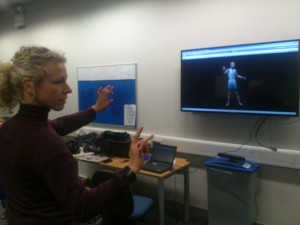On the 2nd of June I demonstrated a new version of iMorphia at a public art event Film Free and Easy in the Primary Art Studios in Nottingham.
By pressing a mouse button, the new version enabled the instant changing of a character between male and female, plus the addition or not of tattoos. Rather than costuming the characters, I chose to create naked characters using the latest edition of MakeHuman. The idea of a person donning a white boiler suit over their clothes then appearing virtually naked I felt added an element of risk and surreal drama to the occasion.
Five visitors to the exhibition chose to experience iMorphia whilst a small audience watched the proceedings. Positive feedback from the participants and audience confirmed the effectiveness of the illusion in producing a strange and disturbing unworldly ghost like character. One person commenting that from a distance they thought they were watching a film, until they came closer and were surprised in realising the character was being projected onto and controlled in real time by a performer.
Recorded footage of iMorphia once again demonstrated how participants creatively exploited glitches produced by Kinect tracking errors. Laughter resulting from one of the participants breaking the tracking entirely by squatting down:

